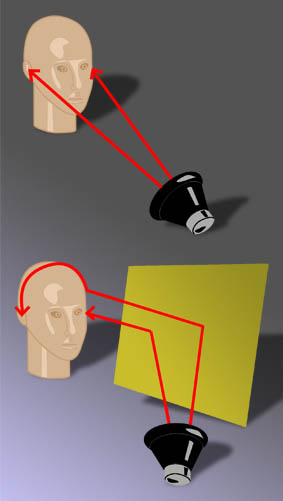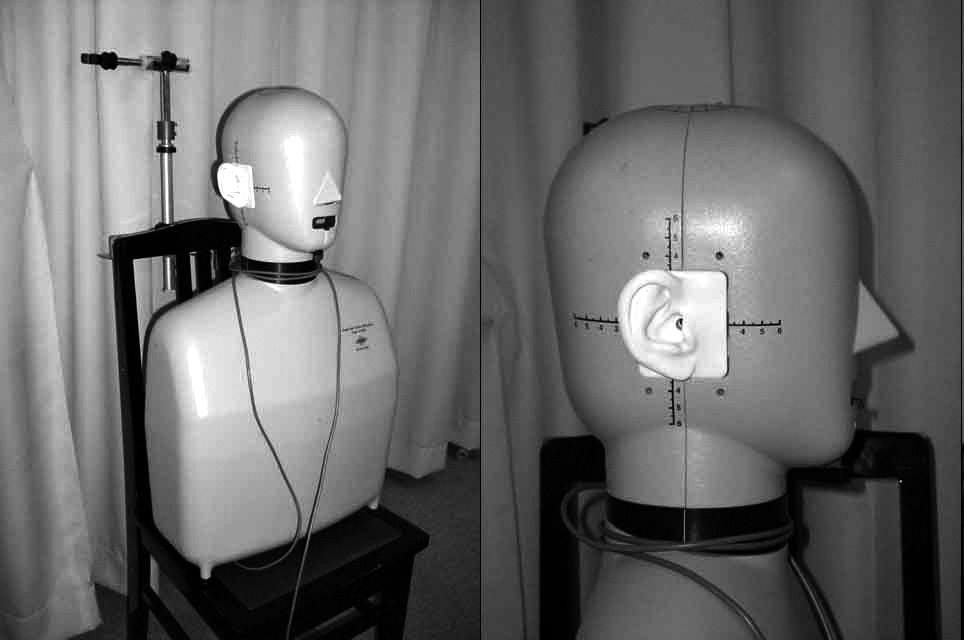Why we have two ears
Diffraction also plays an important role in allowing us to locate sources of sound. If you close your eyes, you can tell which direction sound is coming from. How does this work?

When sound reaches you from straight ahead, the same sound signal is received at both ears. This is because the head is more-or-less symmetrical and the sound to both ears travels an identical path. Your brain uses this information to locate the sound in front of you.
When sound comes from the side (directly, or via a reflection as shown in the picture), the sound at each ear is different. Sound to the furthest ear has to diffract (bend) around the head. This means the sound wave arrives slightly later and is altered in terms of the balance of high and low frequencies it contains. As we have seen, sounds with short wavelengths (high frequencies) don’t diffract as well, so the furthest ear hears fewer high frequencies. The brain senses this difference in arrival time and frequency content, and uses it to locate sound.
So we have two ears because it allows us to locate sound. The is very important for use to be able to track prey and to prevent us getting attacked. Our eyes face front, so it is really important that are ears are very good at hearing things and working our where the sound is coming from.
Surrounded by sound
Recreating a sense of where sound comes from is vital for Virtual Reality. One way to achieve this is to record sound in binaural using a dummy head with microphones in the ears. This means the sound recorded has all the cues for location captured, including the effects of diffraction. Play a binaural recording over headphones and you can hear the sounds surround you like in real life.

Understanding how the brain locates sound is important to create believable immersive sound. I worked with Bjork on a binaural installation at the Museum of Modern Art, New York. The audio would change as the listener’s moved around, allowing them to discover binaural sounds like hidden Icelandic volcanos and geysers.
Creative Audio Technologist, Tony Churnside
![]() Career case study: Why Tony chose to study Acoustics and Audio
Career case study: Why Tony chose to study Acoustics and Audio
Radio and TV Broadcasts
Diffraction also alters the way in which electromagnetic (radio) waves are broadcast and received for radio and TV signals.
TV and VHF radio signals have wavelengths of around a few metres. This means they cannot diffract over hills or large buildings. The receiver must be in direct line-of-sight with the transmitter. Repeater stations are often positioned at the top of hills to reach all the houses in the valley that would otherwise be in the shadow of the hill.
Long-wave radio is sent using waves with a much larger wavelength of around 1km. This means they can diffract around objects including hills and buildings. They can reach places that short-wave radio cannot. This is why it is often possible to listen to long wave radio stations such as radio 4, even when FM reception is poor. It’s also why stations on long wave (BBC Radio 4 – 198LW) are tuned to the same frequency wherever you go – there’s only one transmitter for the whole of England, Wales and Ireland (in Droitwich).
By contrast, FM transmitters only cover a small region. This limited coverage is why you have to continually re-tune a car radio when listening to FM on a long journey. Although if you have an ‘rds’ radio, it does this for you.
Question: Why can’t BBC Radio 1 be broadcast on 98.9 FM over the whole country, using a large number of local transmitters all tuned to the same frequency? (Hint – think about superposition, and constructive and destructive interference).